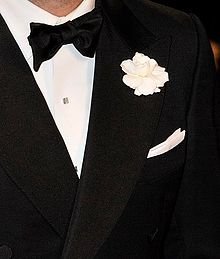
The first dinner jacket is traditionally traced to 1865 on the then Prince of Wales, later King Edward VII (1841–1910). The late 19th century saw gradual introduction of the lounge jacket without tails as a less formal and more comfortable leisure alternative to the frock coat. Similarly, the shorter dinner jacket evolved as a less formal alternative to the dress coat out of the informal smoking jacket, itself an involvement out of the banyan. Thus, in many non-English languages, a dinner jacket is still known as the false friend “smoking”. In American English, its synonym “tuxedo” was derived from the town of Tuxedo Park in New York State, where it was first introduced in 1886 following the example of Europeans. Following the counterculture of the 1960s, black tie has increasingly replaced white tie for more formal settings in the United States, along with cultures influenced by American culture.
Traditionally worn only for events after 6 p.m., black tie is less formal than white tie but more formal than informal or business dress.[2] As semi-formal, black tie are worn for dinner parties (public, fraternities, private) and sometimes even to balls and weddings, although etiquette experts discourage wearing of black tie for weddings. Traditional semi-formal day wear equivalent is black lounge suit. Supplementary semi-formal alternatives may be accepted for black tie: mess dress uniform, religious clothing (such as cassock), folk costumes (such as highland dress), etc.
Black Tie Attire
Black tie attire is slightly less formal than white tie, but it is more formal than business attire. It is the most common formal dress code for events such as weddings, proms, formal dinners, and theatre.
Black Tie Attire for Women
- Formal (floor length) evening gown
- Dressy cocktail dress
- Your dressiest “little black dress”
Black Tie Attire for Men
- Black tuxedo jacket and matching trousers
- Formal (piqué or pleated front) white shirt
- Shirt studs and cuff links
- Black bow tie (silk, satin, or twill)
- Black cummerbund to match tie, or a vest
- Dressy braces to ensure a good fit (optional)
- No gloves
- Black patent shoes and black dress socks
In summer, in the tropics, or on a cruise:
- White dinner jacket, black tuxedo trousers plus other black-tie wardrobe
Black Tie Etiquette
It’s important to treat black tie events with a certain amount of formality, consideration, and respect. Be sure to conduct yourself in a way that reflects these values. Make sure you’re moderate with the food and drink as well. Keep it classy so that you can have fond memories of the black-tie event.
Creative Black Tie:
A creative black tie is best described as attire with a black-tie foundation with room for some creativity and flair. It maintains black tie formality but allows for the use of textures, colors, and accessories to personalize your look.
Creative Black-Tie Attire for Women
- Formal (floor length) evening gown
- Dressy cocktail dress
- Your dressiest “little black dress”
- Fun or unique accessories
Creative Black-Tie Attire for Men
- Tuxedo combined with trendy or whimsical items, such as:
- A black shirt
- A matching colored or patterned bow tie and cummerbund
Black Tie Optional:
A black-tie optional dress code gives guests a couple of formal options to choose from. Men are requested to wear a tuxedo but can opt for a dark suit. Women can choose either a formal evening gown, a shorter cocktail dress, or dressy separates.
 Black Tie Optional for Women
Black Tie Optional for Women
- Formal (floor length) evening gown
- Dressy cocktail dress
- A “little black dress”
- Dressy separates
Black Tie Optional Men
- Tuxedo (see “Black Tie” above)
- Dark suit, white dress shirt, and conservative tie
- Leather dress shoes and dark dress socks

